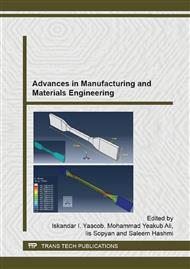[1]
E. S., Gadelmawla, M. M., Koura, T. M. A., Maksoud, I. M., Elewa, & H. H. Soliman, (2002). Roughness parameters. Journal of Materials Processing Technology, 123(1), 133-145.
DOI: 10.1016/s0924-0136(02)00060-2
Google Scholar
[2]
İ., Asiltürk & M. ÇUnkaş, Modeling and prediction of surface roughness in turning operations using artificial neural network and multiple regression method. Expert Systems with Applications, 38(5), (2011). 5826-5832.
DOI: 10.1016/j.eswa.2010.11.041
Google Scholar
[3]
E. Y. T., Adesta, M. H., Al Hazza, M. Y., Suprianto, & M. Riza, (2012). Predicting Surface Roughness with Respect to Process Parameters Using Regression Analysis Models in End Milling. Advanced Materials Research, 576, 99-102.
DOI: 10.4028/www.scientific.net/amr.576.99
Google Scholar
[4]
M. C., Cakir, C., Ensarioglu, & Demirayak, I. (2009). Mathematical modeling of surface roughness for evaluating the effects of cutting parameters and coating material. Journal of materials processing technology, 209(1), 102-109.
DOI: 10.1016/j.jmatprotec.2008.01.050
Google Scholar
[5]
F., Dweiri, M., Al-Jarrah, &, H. Al-Wedyan (2003). Fuzzy surface roughness modeling of CNC down milling of Alumic-79. Journal of Materials Processing Technology, 133(3), 266-275.
DOI: 10.1016/s0924-0136(02)00847-6
Google Scholar
[6]
M. H. F. Al Hazza, E. Y.T. Adesta, Riza, M., & Suprianto, M. Y. (2012). Surface Roughness Optimization in End Milling Using the Multi Objective Genetic Algorithm Approach. Advanced Materials Research, 576, 103-106.
DOI: 10.4028/www.scientific.net/amr.576.103
Google Scholar
[7]
M. H.F. Al Hazza, & E. Y. T. Adesta, (2013, December). Investigation of the effect of cutting speed on the Surface Roughness parameters in CNC End Milling using Artificial Neural Network. In IOP Conference Series: Materials Science and Engineering (Vol. 53, No. 1, p.012089.
DOI: 10.1088/1757-899x/53/1/012089
Google Scholar
[8]
M., Nalbant, H., Gokkaya, & I. Toktas, Comparison of regression and artificial neural network models for surface roughness prediction with the cutting parameters in CNC turning. Modelling and Simulation in Engineering, 2007(2), 3.
DOI: 10.1155/2007/92717
Google Scholar
[9]
P., Kovac, D., Rodic, V., Pucovsky, B., Savkovic, & M. Gostimirovic, (2012). Application of fuzzy logic and regression analysis for modeling surface roughness in face milling. Journal of Intelligent Manufacturing, 1-8.
DOI: 10.1007/s10845-012-0623-z
Google Scholar
[10]
B., Samanta, W., Erevelles, & Y. Omurtag, (2008). Prediction of workpiece surface roughness using soft computing. Proceedings of the Institution of Mechanical Engineers, Part B: Journal of Engineering Manufacture, 222(10), 1221-1232.
DOI: 10.1243/09544054jem1035
Google Scholar
[11]
Zadeh, L. A. (1965). Fuzzy sets. Information and control, 8(3), 338-353.
Google Scholar


